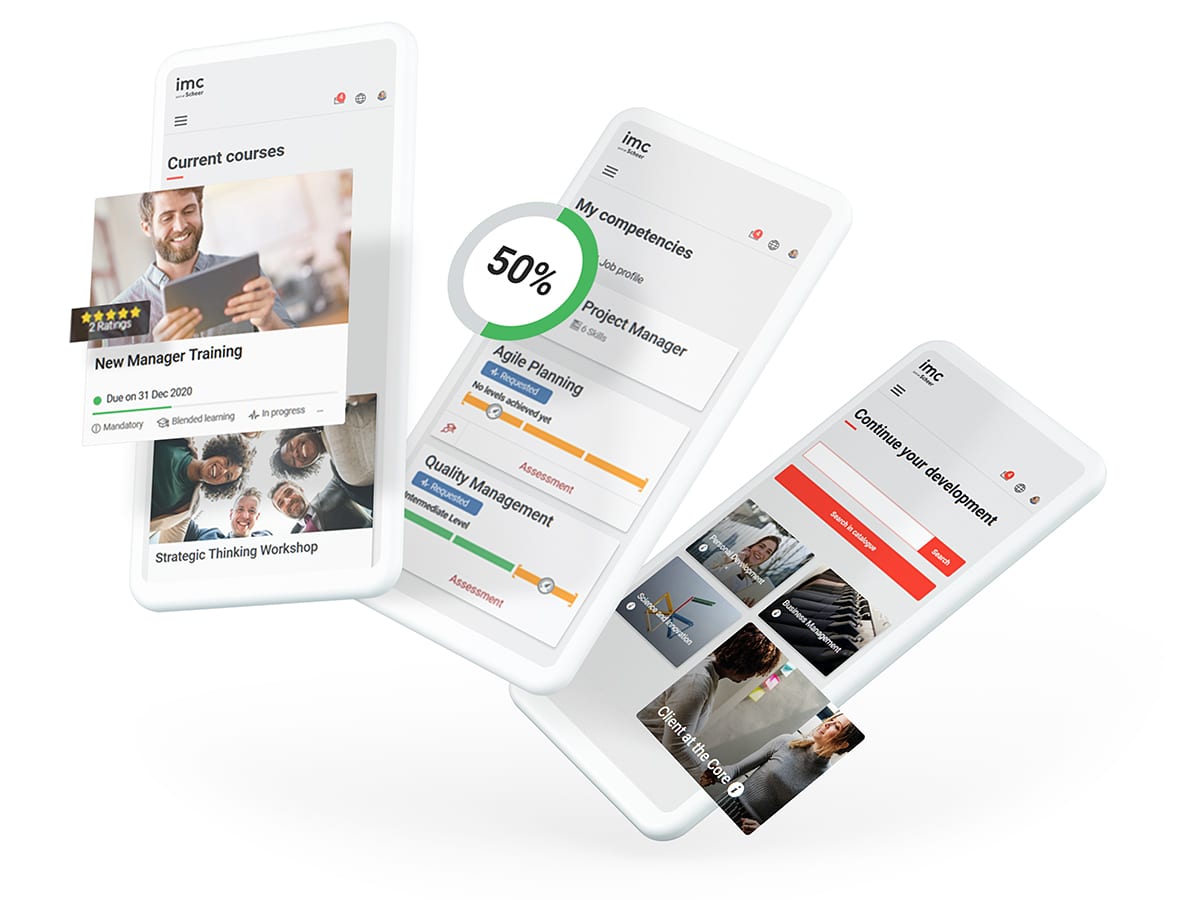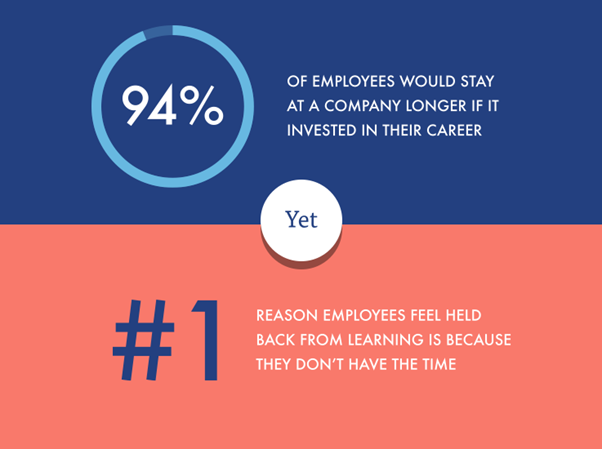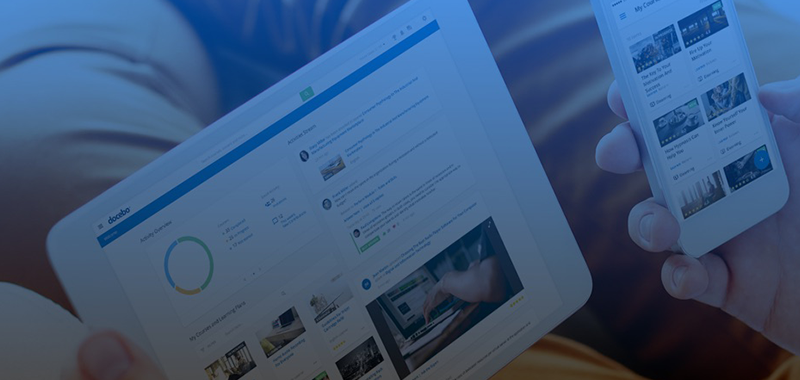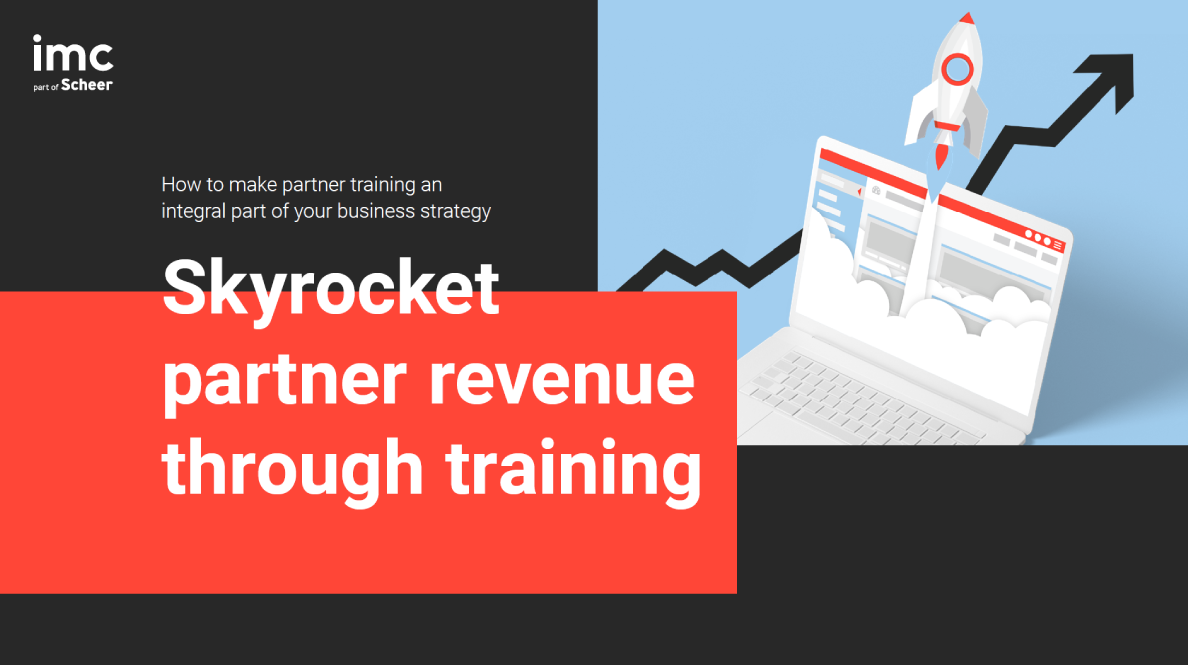
Creating the Perfect Learning Experience for a Remote or Hybrid Workforce
Times have changed for L&D - while many large organisations were already putting resources into digital transformation, our workforce is now more dispersed, with hybrid and remote working looking like it’s here to stay even post-Covid.
Alongside these trends, we have ubiquitous access to more information through ever-faster Internet and mobile devices, while top talent expect to be supported in their professional development - otherwise, they will move on.
What remains the same are people and their motivations. People are fundamental to any company, and what drives a company forward and helps it to stay afloat in a competitive market is an engaged, well-informed and adaptable workforce.
Here we look at how to facilitate the personal and professional development of top talent by creating the perfect learning experience for a remote or hybrid workforce, so that training can become a key competitive advantage.

Technology and a Learning Ecosystem
Keeping your workforce at the forefront of your industry requires regular formal training, but also informal and rapid knowledge sharing between employees and departments.
The ability to respond quickly to new products, services, industry guidance and competitive environments through learning will give any company a competitive edge, but this can be diminished when working remotely.
Whether we’re training face-to-face, digitally or virtually, the fundamentals have remained the same for a very long time; we’re socially motivated learners who need context, reinforcement and practice to acquire new skills. We don’t respond well to formless, monotone, poorly presented content, and we don’t retain information as effectively when we’re not engaged. Making your learning journey engaging, enticing and efficient is where technology can come in.
Technology has revolutionised how we design and deliver learning experiences. Today, learners expect a digital training experience that’s accessible, flexible and engaging.
They’re used to platforms such as Netflix that neatly package and categorise content for them, and offer a library and playlists with a user-friendly interface.

There are a wide variety of digital and online tools that can help learners have a positive learning experience. These are especially useful when it comes to mandatory training, such as for legal or industry compliance, which employees know they need to undertake but may not necessarily be enthusiastic about.
It doesn’t matter how engaging and talented your experts may be, if the platforms and tools you’re using to host a learning journey aren’t up to scratch then your learner will find it difficult to focus.
When seamlessly integrated, there are 3 key L&D tools that can help you create the perfect learning experience even when your teams are disparate. These are the LMS, LXP, and rapid content authoring tools - let’s examine each in turn.
What is a Learning Management System?
A Learning Management System (LMS) maintains, tracks and records a learner's journey, including analysing their comprehension of subject matter and completion of learning events. An LMS will help L&D managers track an individual's or a group’s progress through training by serving as a system of record and audit, and pinpointing where they may need additional help or support.
There are several types of Learning Management System which meet various needs and budgets, including open source software, deployed or Software as a Service (SaaS) solutions. An open source solution is free at the point of access and has a committed online community that will update it regularly, rolling out improvements and add-ons for all to use. It can be a good option for companies with tight budgets who desire something to enhance their learning experience without breaking the bank. However, it can be a security risk without expert set-up and support, and can often be plain and uninspiring out of the box, requiring a great deal of design and customisation - all of which comes at a cost of course.
A hosted or Software as a Service (SaaS) system runs on someone else's server, is set up by a provider and may offer a more customised solution compared to open source software. These systems are usually quite ready to use out of the box.
A deployed LMS solution is set up on computers within your premises, which has its pros and cons. There are greater up-front costs to install the LMS software on-site, but it may save you more money in the long run. This might be a good choice in highly regulated industries and when you have the in-house technical expertise to maintain it.
Historically, the LMS can be unintuitive, unattractive and complex for the user, making it difficult to navigate and read or watch the learning content. In some cases, a badly designed LMS can create more of a hurdle to learning than the content itself.

The best LMS, such as what can be found within imc’s Learning Suite, create an easy to use learning journey though, so that learning can be an engaging activity rather than a chore.
An LMS is often seen as a solution for top-down training mandated (or at least encouraged by) the employer. It’s not really designed for self-motivated learners to explore new learning opportunities. This is where a Learning Experience Platform can come in…
What is a Learning Experience Platform?
A Learning Experience Platform (LXP) is the Netflix of the learning technology world. A quality learning experience is designed to entice, encourage and excite learners to consume the content. It’s for self-motivated learning to develop their personal and professional knowledge and skills, which in turn will usually bear fruit for the employer too.
The LXP is designed to be more intuitive to use than the LMS, and utilised effectively, it should provide contextualised, relevant and custom content from multiple sources in order to cater for different learning styles and preferences.
It’s a diverse learning ecosystem of multimedia content exploration.
LXPs enable you to create a personalised experience that can curate and recommend the best content for each person.
We were talking earlier about how hard it can be to motivate people to undertake essential, mandatory training, such as compliance. Well, an expertly executed LXP should make learning feel fun and easy for your learner, yes really - fun, and in turn, hopefully, it will help employees to feel supported and valued, and help to create a culture of learning within an organisation.
Think of the difference between using Netflix or scrolling a government site, what one would you prefer to use? The more at ease and enthused your learners feel in their learning environment the better their journey will be.
The imc Learning Suite combines the best of both an LMS and LXP - giving L&D teams what they need to deliver and track training, and giving employees a place to explore learning opportunities for personal and professional development.
What are rapid content authoring tools and how can they help me create quality training content?
Rapid content authoring tools are a form of software that enables experts to create and package learning content using various forms of media. It means your experts or training managers can create new content, make changes and send updates to learners quickly and easily. The working landscape is ever evolving, especially in post-covid times with hybrid working becoming the norm, and tools such as rapid content authoring empower companies to respond swiftly to changes and stay relevant.
Adopting content authoring tools can enhance your digital transformation journey as a company, empowering experts and learning and development professionals to create adaptive engaging content promptly.
Rapid content authoring tools can help you:
- Repurpose existing content quickly
- Keep development costs low
- Respond swiftly to new products, services, market or environmental changes
- Update and upscale content quickly
- Deliver knowledge in easy-to-digest chunks
- Share content with learners on any device
Content-authoring tools include software Articulate Storyline, Adobe Captivate, Lectora and Camtasia. However, you might have in-house subject matter experts willing and ready to create and share their experience and expertise if they can avoid the learning curve of software used by professional instructional designers.
imc Express enables the quick creation of elearning materials that are rich, engaging and multimedia, but without that learning curve.

What is a healthy learning ecosystem?
A learning ecosystem comprises the elements that make up your user's learning journey and environment including the tools, platforms and technologies. Just like the natural ecosystem, the more diverse the learning environment, the more effective the learning will be.
A complete, well-integrated Learning Suite can enhance not only your learners' experience but your subject matter experts' effectiveness too, enabling them to build engaging content and communicate quickly and efficiently to drive knowledge sharing.

A complete learning experience
Technology helps learners have a positive learning experience, especially when it comes to compulsory training where they may lack the motivation to complete.
Learners today expect training to be engaging, entertaining and diverse in format. This is especially true as remote and hybrid working is on the rise and our workforce becomes more distributed.
People are looking for social connection, a platform that is instinctive to use and easy to digest content that they can absorb and experience digitally or virtually. The latest and best in learning technology can help us achieve all of this.
Want to learn more about leveraging the latest technology to create the perfect learning experience for a remote or hybrid workforce? Contact us here at imc Learning.

Turning a learning curve into an earning curve
Set online training up for success in such an extended enterprise learning scenario, and how to turn a learning curve into an earning curve.

Learning Management System for Membership Organisations
Make your platform effective for current and future training needs for your membership organisation.

Training Digitisation – Leverage knowledge sharing among your people
Here we look at the important topics of knowledge sharing and training digitisation, with tips on how to leverage the experience of your employees to improve performance and future-proof your business.
For many businesses, especially those within the knowledge-based economy, existing employees are their greatest asset. Staff turnover is expensive for any business. Studies show that the direct cost of replacement is over £30,000 on average to replace an employee earning over £25,000 per annum. However, more detrimental is often the indirect cost that comes with losing valuable knowledge and experience - something that is far harder to measure.
Facilitating and encouraging knowledge sharing across your organisation can be an extremely effective way to both enhance productivity within your existing teams and mitigate the brain drain that comes with staff turnover.
While your L&D department can roll out training programmes in a planned and centralised manner, a culture of knowledge sharing and a toolkit that makes it easy means that information can be shared at the speed of need (‘Just in Time Learning’) and when it’s convenient for subject matter experts to do so.

Knowledge Sharing Definition
Knowledge sharing is the exchange of information, skills and experience between individuals or across groups. When expertise is shared by an experienced person, it allows further people to benefit from that experience in order to boost their own performance and that of their peers, potentially strengthening an entire organisation.
Much knowledge sharing occurs naturally and accidentally through day to day interactions and conversations - those ‘water-cooler’ moments that characterise informal learning or tacit knowledge. Of course, the Covid-19 pandemic has caused (or at least accelerated) the transition to a hybrid or fully-remote work environment, making the accidental water-cooler conversation much less likely for many.
That informal kind of knowledge transfer is a social activity that is often hard to describe and organise - it comes with nuance, intuition and the free-flow of ideas.
However, explicit knowledge is something that can be more planned for and organised, so that specific information can be codified and made available to others.
The main attributes of explicit knowledge sharing are:
- Describable - the subject matter expert must be able to clearly articulate the information and experience they want to share
- Visible - the recipient must be made aware that the learning materials exist
- Accessible - the recipient must be able to open and consume the content where and when they need it
- Organised - the recipient must be able to navigate learning materials so that they can be consumed in a structured manner without confusion or information overload
- Complete - the education or training content should fit into a wider organisational context, signpost further related information where needed, and clarify any distinction between self-published, employee-generated content and the more top-down learning materials created by an L&D team.
Knowledge Sharing Benefits
When you have in-house expertise, you’ll want existing and future employees to be able to access it and enhance their own performance as a result. Knowledge sharing benefits can grow exponentially across a large organisation, spawning new ideas and strengthening the collective brain.
With a culture of knowledge sharing and providing the tools for digitising content, along with the structures to support it, a company can gain a great deal of competitive advantage. Some of the many benefits of knowledge sharing include:

If important knowledge is shared frequently and in a well-organised manner, the loss and disruption caused by a key employee leaving is greatly reduced.
Information shared by the leaver can be made available to their peers and / or successor, in addition to the general onboarding and training materials.
While guarding against brain drain is about making the organisation resilient to employee departures by being agile in a reactive situation, succession planning is about looking ahead to (perhaps even scheduling) departures and promotions. This includes the process of knowledge transfer that will need to take place during that transition.
Starting in Spring 2021 during the Covid-19 pandemic, employees voluntarily leaving their jobs en-masse in many countries - most notably the US - was a trend dubbed ‘The Great Resignation’ by organisational psychologist Dr Anthony Klotz.
The pandemic caused employees in many countries to rethink their work-life balance and many countries, including the likes of the UK, Australia and Canada as well as the US, saw resignations increase, in addition to the millions of forced redundancies.
Regardless of Covid-19, millions of ‘baby boomers’ - those born between 1946 and 1964 - are now hitting retirement age. This large cohort of the population holds vast amounts of information and experience to share with their Generation X, Millennial and Gen Z successors.
Two of the great frustrations among business leaders are duplication of effort across teams that wastes resources and a lack of communication that prevents learning from previous mistakes.
With greater insight into what other groups are doing or have done in the past - good and bad, knowledge sharing helps time and resources to be used more effectively.
When individuals hoard information (albeit unintentionally most of the time), trust among peers is diminished.
Providing employees with knowledge building tools, such as the ability to quickly and easily create and share digital training materials, more employees will feel supported by each other and that they are working collaboratively as part of a genuine team.

Employees often feel that they are not being listened to, which can lead to discontent and potentially resignations as a result. Rather than only experience top-down training that can feel disconnected from their real-like working environment, knowledge sharing tools and processes can help employees at every level to create learning materials that help to provide management support and information gathering.
This can then influence subsequent onboarding and training materials created by management and L&D teams, making them more contextually relevant.
The 70:20:10 learning methodology proposes that, on average, 70% of workplace learning is done ‘on the job’, while 20% is done through the sharing of knowledge between peers and only 10% is through formal, top-down onboarding and training.
That 20% part in the middle goes both ways - not only does the recipient benefit from information shared by the expert (making the 70% on the job part feel better supported) but the action of sharing knowledge can actually strengthen even the expert’s understanding of a subject.
Studies such as this one detailed in the Applied Cognitive Psychology journal show that learning by teaching others is extremely effective because it enhances the pathways of knowledge retrieval.

Training Digitisation & Knowledge Sharing Tools
Digitising training makes it possible to store and share information with an unlimited number of employees, even across territories, virtually instantly. A good, modern elearning content authoring tool makes it easy for any of your employees - regardless of their technical skills - to share knowledge digitally.
Such an authoring tool, like imc Express, can immediately benefit colleagues in any location via the cloud, while this form of training digitisation makes more knowledge available for future recruits too.
This is about employee-generated training content, and each person will have their own preferences around the style and media they feel most comfortable using for knowledge sharing.
Therefore, you’ll want to make sure your authoring tool enables content creation and sharing though any combination of:
- Text
- Audio
- Video (including subtitling)
- Images
- Interactive elements
There should be little to no learning curve when it comes to an elearning authoring tool for employee-generated training software. It should be easy to access on any device, easy to use, and make the sharing of materials a fast and simple process.
It should also provide visual elements out of the box to make that training eye-catching and engaging by default so that your people can be proud of the materials they create - without needing to work at it.
For over 20 years, we’ve worked with some of the world’s leading brands, such as Audi, BASF, Sky, Deloitte and Vodafone, supporting their training needs with elearning solutions.
This experience has enabled us to create an elearning toolkit that makes it easy for them to digitise training content and make it accessible across multiple locations, countries and even languages.
If you’d like to learn more about how our solutions could enhance training digitisation and knowledge sharing within your organisation, feel free to contact us for an informal chat about your needs and goals.

Courage to the LMS - also as SME!
Not only big companies should have the courage to go for a Learning Management System (LMS). In our interview Christian Mai from S&G Mercedes Benz, tells about his experiences with rolling out an LMS in a Small and Medium Enterprise (SME).

The big e-learning glossary
WBT, SCORM, Predictive Analytics, Blended Learning - uh, what? The first two articles in this series are a glossary for those who have felt lost in the e-learning jungle of abbreviations and technical terms.

Panel Talk: Fosway Group, Learning Light and imc
As businesses emerged from lockdown and social distancing measures in many parts of the world, elearning experts from imc, Fosway and Learning Light got together remotely to discuss the post-pandemic future of learning platforms in 2022 and beyond.
Key topics discussed include:
- LMS, LXP, NGDLE, Suites…?
- Headless LMS
- Concrete Advice for the Learning Platform Buyer
- Learning Designer to Performance Consultant
Hosted by Alison West, Pre-Sales Consultant of imc Learning in London, the panel of experts discussing these topics consisted of:

Fiona Leteney
Senior Analyst at Fosway Group, who has worked in the learning technology market for over two decades, and brings a wealth of insights from customers, vendors and the market.

David Patterson
Lead eLearning Consultant at Learning Light, who has been influential in the world of elearning and learning technologies for over a decade.

Sven Becker
Executive Board Member at imc, with over a decade’s experience from the vendor’s perspective.

LMS, LXP, NGDLE, Suites…?
Alison kicked off the discussion commenting that there is a large and growing list of terminology describing the learning platforms used for education and training today, so asked David to, for those uninitiated in some of these terms, to describe the differences between them.
David
The learning management system (LMS) has been around as a term for many many years, probably dating back to the late 1990s.
Recently we’ve seen the evolution of the term learning experience platform (LXP), which is interesting as people are trying to present a new take on digital learning. Part of the motivation is that a new such platform is not an LMS, which is more process-focused, whereas the LXP is more content-orientated.
However, in David’s view, we are now seeing these two types of platform on the market fuse together, with many LMS providers adding LXP functionality and vice-versa.
Does this matter? Well yes - I buyer of these learning technologies will want to have a clear understanding of what these terms mean. So it’s important, and a goal of this discussion, to explain and simplify some of the terms being used today.
Alison commented to Fiona that at Fosway, they seem to be moving away from terms such as LMS and LXP and using words such as Suites, asking why that is.
Fiona
Building on what David said, Fosway have also been seeing a merging of the ideas of LMS and LXP. In fact, before the concept of Suites, Fosway had been using the term Next Gen Learning Environment as a term, because they never really saw LXP as a valid term to describe what a system does.
In Fosway’s view, LXP is a marketing term, which was launched into the market and everyone latched onto it. This was because buyers wanted to be buying into the latest technology as opposed to a ‘legacy LMS’. At the same time, vendors didn’t want to be seen as a legacy LMS so adopted the term as well.
In reality, when talking to a corporate learning platform, when Fosway ask what they mean when they say they are looking for an LXP, the answer is always very different. So, it was a couple of years ago that Fosway started moving away from using the words LMS and LXP and started talking about Suites and ‘Specialists’.
For example, if you’re a smaller organisation and you only have budget for one system - that’s when you need a Suite, because that’s going to give you the broader range of functionality that you’re going to need. If you then have the opportunity to dig deeper into a particular area, you then might look at one of the Specialists.
Perhaps you’d look at a specialist tool for content curation, or one that focuses on Instructor-Led Training (ILT). Perhaps you’d add these in, and some vendors facilitate this, whitelisted, to add depth of specialism.
That’s why Fosway use the term Suite for not only learning systems, but across HR technology as well.
So, Suites for broad capability, with Specialists usually focusing on just one area.
Alison then put the same question to Sven to gain the platform provider’s perspective.
Sven
This difference these days is that there is no longer a clear orientation driven by the customer. imc traditionally built systems that were relatively process-driven as David had mentioned.
The idea of ‘Learning Experience’ was seen as a commodity - normal for imc’s solutions. Learning Experience is a concept, not a system, so to create a good learning experience, you need to look at the concepts from the learner’s perspective.
An important shift is to look ahead, years into the future, when creating an LMS, NGLP (Next Generation Learning Platform) or whatever you want to call it. It isn’t just about post-covid planning - that’s an obvious example, but it should have been part of the thinking long before that and must look beyond the immediacy of pandemic and post-pandemic requirements.
What is the user’s working environment? For many, it revolves around a mobile world and great systems are considering the needs of users who need a mobile-first learning system.
It’s not just about “does this look good on both a desktop and a mobile” - what is the environment of both types of user? Does the mobile user have different sound restrictions because they might be learning on a busy train for example?
To broaden the conceptual thinking even further on the part of the vendor, we need to think about the complete Employee Experience and how does learning dovetail with that. After all, learning experience is just part of the employee experience.
So, for those feeling overwhelmed by all the terminology still around and the level of choice and complexity involved in the buying process, how should the buyer deal with that overwhelm?
David
“Listen to someone like Fiona or myself!” People at the likes of Fosway and Learning Light spend their time listening to the business needs of organisations and developing an understanding of their learning requirements.
From that, a consultant can uncover the types of learning technology that the buyer will need. Sven made a good point that learning experience is really a concept, rather than a system, and that’s an important takeaway. There will, though, always be technology that facilitates that - and some doing it better than others.
Learning Suite is a useful term as well - and the best suites are getting bigger and more capable than ever before. Therefore, it’s important as the client to establish in advance what your learning outcomes are, what the learner journeys are, and what the data is that you’re going to need to understand to underpin your learning and bring back to the wider organisation.

Headless LMS
So, what is the headless LMS and how is it different from integration of deep content?
David
The concept of the headless LMS has emerged based on the world of content marketing. It springs from the idea of the headless CMS (content management system).
What those systems do is push content out across every channel. The ‘head’ used to be the website, but that has been kind of cut off. The CMS now is presenting content through social media channels, productivity suites, websites and even VR.
Several learning platform vendors have looked at this trend and said “Yes - this is a valid concept for learning as well”.
This is an evolution, not a revolution, as some companies such as imc have been pushing out highly evolved APIs and deep links into learning platforms and integrated content. The headless LMS is simply the next step on this journey, putting the player into the system.
So, the player will start to appear within Microsoft Teams, Slack, your CRM or your CMS, and the learning will then be instantly available to your learners at the very moment they need it. Incredibly rich data will then come back into the core learning platform / suite and really enhance your overall business analytics as well.
Fiona
There are two requirements that tend to focus corporate engagement with Fosway. Often, large organisations are managing multiple learning platforms and are looking for a single point of access to avoid or eliminate confusion.
On the other hand, some companies want to facilitate access to learning wherever the learners happen to be at any point in time, and to then feed back into the learning system.
This highlights the need for integration. Back at the start of the pandemic, 84% of business leaders were saying “Now more than ever, we need to integrate the learning systems with our business applications, such as MS Teams or Slack”.
Fosway brought together a dozen corporate leaders for a roundtable discussion of this issue, and found among them a lot of frustration with the complexity involved in making integration happen. Yes, APIs exist, but it’s rarely as simple an exercise as they were sold on.
Like David said, the headless LMS is an important concept that is starting to improve this, and learning systems like imc are helping in ensuring that data is flowing through the whole tech ecosystem. This includes the learning ecosystem of course, but also the HR systems and the wider business ecosystems out there.
The more we can get that data flowing through the whole ecosystem, the better our business decision making can be, and it’s that need for integration that’s coming through loud and clear from corporates.
Sven
It’s important to note that headless LMS is not just the next marketing term - headless is a complex monster!
Sometimes vendors say “it’s OK, we have open APIs, everything is easy” but then the customer finds that this isn’t true. API management is one of the most complex areas of IT. This is why we have to talk about things like RPA - Robotic Process Automation - to help with API management.
Again, headless is a concept, not a technology, and it’s about how we structure our learning ecosystem. The learning ecosystem is a culture thing, not a technology thing.
This is all about the flow of work - “how can we bring content to our people more easily?”.
For example, way back in 2009, Deloitte published a study where they had looked at the modern learner. They found that even then, on average people were looking at their smartphone 9 times per hour to check if there was a new message.
So we are driven by the ‘pull’ of information. The current standard learning management system is not ready for this - you have to log in, go to your course, open the right bit of learning etc - but that’s just not how we interact with information today.
If we know that people are checking their phones anyway, why don’t we push information in that direction, such as a reminder about key points from last week’s instructor-led training for example - when and where it might be helpful and appropriate.
Where this will become more important over the next 5 years is in the greater adoption of IoT - the Internet of Things.
We already have Internet enabled fridges. A fridge is able to ‘buy’ milk. In the same way, if we can see that a member of the team is on the train on their way to see a client, why not send them a push notification with three key points to remember about that client for example?
This is learning in the flow of work - it’s context-based and it’s what we mean by headless. If we think purely in ‘portal’ terms, whether it’s LMS, LXP or whatever, where you have to go and log in, we’re creating a specific access point for learning and that just won’t be the future.
Learning should be ubiquitous, around us all the time, and the culture should be driven by the learners themselves and how they work.
Sometimes, customers come to imc and say “give us all the APIs and let’s integrate everything” but we try to say “wait, let’s look at what we need, let’s look at the culture you are trying to create”.

Concrete Advice for the Learning Platform Buyer
So, for those looking to ensure their elearning system is future-ready and future-proof, what concrete advice can you give to a learning platform buyer in the post-covid world?
David
It really is about starting at and thinking through at the conceptual level. My own work is a lot about building conceptual models and looking at the information flows around that.
Worry first about how you want to structure your learning and keep the needs of your learners front of mind at all times. The choice of technology can then come after that and be based on how you want to deliver on those learner needs.
Fiona
Of course, Covid has meant that we’ve needed to move more of our training online. We’ve been talking a lot about bite size learning and microlearning for sometime, but the highest value training - onboarding and leadership - has traditionally been classroom-based.
That kind of training has very quickly been moved online - which was necessary and it’s great that it happened, but we now need to look very carefully from the corporate, vendor and learner perspectives at what that should really look like.
20 years ago, we went from classroom-based training to elearning for all the compliance stuff. This took the engagement piece out of the mix along with the trainer, and people started to hate the ‘click Next’ style elearning - rightly so.
The risk now is that learners could start to hate more areas of training now that more has been moved online if we don’t get it right. We need to create a safe place of learning where people can join their cohort to collaborate, do joint assignments etc.
We need to look carefully at how learning technology can best facilitate this and must not now sit back on our laurels and say - “we got all our training online so all is fine”.
Learning Designer to Performance Consultant
Sven built on the buyer tips from Fiona and David, offering advice on how L&D approaches elearning…
Sven
We might want to look at how learning is structured within the organisation and perhaps move some L&D roles away from just learning design and into being more of a ‘Performance Consultant’.
A learning designer always asks “what is the learning outcome of this programme?”. We need to ask ourselves ”What is the business outcome?”.
This is often the failure of learning design - we identify a learning outcome but it doesn’t feed into any business outcome.
When you move the Learning Designer to become more of a Performance Consultant, you start to create the best of both worlds - learning outcomes that are fully aligned with the business goals.

Fosway Group: "Focus on your learning ecosystem"
Terms such as LMS, NGLE and LXP are confusing for corporate buyers.
Fosway Group's learning industry analyst Fiona Leteney dives into the matter.

Informal learning: Everyday hero of work
“Formal learning is like riding a bus. Informal learning is more like cycling.” We explain what this means and share some key facts and recomemndations

More about our LMS
If you would like to learn more about imc's Learning Management, check here for more information.


What is Digital Learning Transformation and how does L&D maximise its impact?
Digital Learning Transformation is about much more than taking your offline training materials and making them viewable online. It’s a complete, collective mindset change in how training gets done across an entire organisation.
In this blog, we offer a brief introduction to the concept of digital learning transformation, including the reasons and expected benefits and - if you’re in L&D - how to do it well.

The Broader Digital Transformation Context
Digital transformation is a managed approach to integrating digital technologies across all areas of an organisation. It marks a fundamental change in how business gets done.
Every business will have its own priorities and pain points that may be the primary driver(s) of digital transformation, but the goals and incentives tend to include:
- Cost savings and increased efficiency through reduced need for travel, time on face to face or paper-based communication, etc
- Greater cross-departmental knowledge sharing, breaking down silos and leading to new cocktails of ideas
- Enhanced data gathering, giving leaders more insight into trends, customer needs, opportunities and threats - enabling better-informed strategies to be formed
- Future-proofing the organisation, making it more adaptable to change and the integration of new solutions that build upon the existing technologies.
While digital transformation as a concept has taken hold over the last 5 years and seen accelerated demand since 2020 in the midst of the Covid-19 pandemic, its business benefits have long been demonstrated. In fact, research by MIT back in 2013 showed that digitally mature companies were 26% more profitable than their peers.
Those that lag in this area risk getting left even further behind more digitally-focused companies in 2022 and beyond.

eLearning for Employee Engagement, Performance & Retention
Few large organisations in 2022 have wanted to or been able to continue with face to face onboarding and training during the pandemic. While most will have had a level of elearning already in place for the basics of company processes and compliance training, many then took the same principles to further L&D content, making it available online via a learning management system (LMS).
However, it's crucial to view this solution as an extension of existing box-ticking exercises required for health and safety or other compliance training that short-changes employees and the business as a whole.
LinkedIn’s 2018 Workplace Learning Report found that 69% of non-millennials see development as important in a job, while this figure rises to 87% for millennials. This means that the competitive advantage to be gained from enhancing learning and development opportunities will increase in its importance for engaging employees over the coming years.
The benefits of eLearning for staff retention are even clearer:

Source: LinkedIn Workplace Learning Report
According to research by Oxford Economics and Unum, the cost of replacing an employee earning £25,000 is over £30,000 on average when you factor in all costs, and this may not even account for the associated inefficiencies caused by disruption and loss of knowledge and experience.
Digital learning transformation looks at how to not only make elearning possible but how to make training as effective, engaging and enjoyable as possible.
As 94% of employees would stay longer if they felt their company was investing in their career, making learning materials not only accessible but engaging and personalised through an integrated Learning Suite could bring vast improvements in morale and reduce attrition.
Such a system combines the top-down training facilitated by an LMS with the bottom-up, employee-led learning characterised by a Learning Experience Platform (LXP). Investment in such digital learning solutions could be repaid many times over across a large organisation from just the reduced recruitment costs alone.
Transformation Buy-In at Leadership Level
For digital learning transformation to have a real impact across the organisation, L&D managers need to first ensure buy-in from their fellow leaders, starting from the top:

CEO
The big boss loves speed - in decision making, in implementation, and in bottom-line results. Demonstrate how digital learning will enable new products and services to be rolled out faster, as training can be created and delivered quickly, even across borders, and updated with minimal time and fuss down the line.

Head of Finance
A key consideration for finance is minimising and cutting costs where possible of course. Sell the idea of digital learning to this team on the basis that it reduces costs in the way of face to face trainers, room hire, travel and materials. Rather than an investment (a cost), it is a cost-saving device for which you may be able to demonstrate a clear business case and ROI.

Head of IT
The techies love control. Rather than selling the Head of IT on the concept of digital learning, you may find that he or she is enthusiastic but wants to be actively involved to ensure integration with existing systems. See this as a collaboration where you may need to hand over a level of control.

Legal
A well set up learning platform is a powerful asset for legal/regulatory compliance. It provides clear information on required training and can provide alerts when refresher training is required. An easy sell to an in-house or external legal team.

HR
Recruitment, onboarding, training, morale and retention are all key considerations for the Head of HR. L&D and HR are closely aligned anyway - if not part of the same People department. Digital Learning Transformation does require a great deal of data sharing and integration with HR systems, but done well, HR and L&D will have a seamless, beautiful relationship for ever after.
Key Steps to Digital Learning Transformation
A digital learning transformation programme requires careful planning, implementation, assessment and improvement. Any such technology implementation can be broken down into distinct steps for success:
- Plan
- Consult
- Implement
- Test
- Measure & Analyse
- Improve
To break each step down into greater detail:

Plan
You will have done a level of planning in order to win the support of department heads. In order to maintain that support, you’ll need to carefully scope and cost the technologies you’re looking to introduce and the human resources needed for their implementation.
What existing processes will be retired and what are the direct replacements for each one in the new digital learning environment?
As so many technology projects stray beyond expected timescales, give yourself plenty of buffer time so that you don’t miss deadlines and start losing support from your peers.
Consult
Communication is vital for a successful digital learning transformation programme. Many IT projects fail not through a poor choice of technology, but through lack of communication beforehand in order to generate understanding and buy-in from end-users.
At the consultation stage, learn about what the key pain-points are within each department and try to tailor your digital learning solutions to help ease them.
Help each department to understand the benefits of digital learning transformation for their roles and you’ll find less friction and greater user adoption of new systems and processes post-implementation.
Implement
Don’t try to implement every project within the digital transformation programme in one spectacular hit. There will be disruption - good and bad - so limit the bad and overall shock to the organisation by rolling out to a limited cohort - perhaps the department where you have greatest buy-in first.
Introduce new tech and eLearning content gradually, replacing previous training methods bit by bit. Look for what systems and content people are finding confusing and what really enthuses them.
Test & Measure
As your early-stage digital learning projects bed in, analyse the data that comes back from your learning platform. What are the key metrics you are looking to improve and how does the new solution fare compared to previous methods?
Analyse, Discuss & Improve
Again, communication is essential to making your digital learning programme maintain its early momentum. You’re gathering quantitative data, but don’t ignore qualitative feedback from each group of learners and their managers.
What has been annoying? What hasn’t worked? What could be improved?
Within each individual roll-out project, mistakes will be made - that’s normal. Those mistakes will be forgiven if you listen to the feedback, take notes, and act as quickly as possible to address them with tweaks to your roll-out.
Transform the Culture
There is only some much you can do in leading a digital learning transformation programme before it could feel less collaborative and more like another top-down demand. Who has engaged most with both the process and the benefits from the early stage implementations?
Laser in on these people and try to empower them as advocates of the new solutions - even coaches for their peers who could use support.
With an army of internal activists, user adoption can start to spread like wildfire, making your digital learning take hold and really transform the culture of your organisation.
Hopefully, the above points have given you some useful food for thought in advance of your own digital learning transformation programme.
If you’d like to speak to one of our digital learning experts to discuss how our experienced team and solutions could help you, do feel free to contact us here at imc for an informal discussion of your organisation’s requirements.

Compliance in Digital Learning Transformation
Get to know more about the five benefits of how compliance training can make digital learning transformation a fundamental part of a progressive, digitally-savvy organisation.

Connecting Learning and Business Performance
A forum article about how leading businesses in Australia connect their learning journeys to their wider organisational objectives.
Contact person


Learning Management Systems for Membership Organisations - Key Features to Look For
Here we look at the unique requirements you should look for in a learning management system (LMS) for membership organisations, in order to make your platform effective for current and future training needs, while improving many other aspects of member administration.
Over the last few years, many professional bodies and trade associations have added online training, services and member benefits via an LMS to supplement their offline offerings.
However, as everyone is becoming more tech savvy and comfortable in doing more of their business and social networking online, many membership organisations now conduct the majority of their communication via an LMS or online portal, with some even being primarily or entirely run online.
Add to this the need for social distancing and remote communication while the coronavirus pandemic continues through 2021, and many membership organisations need an online hub to be able to function at all.
Often, generic LMS solutions can technically be adapted to meet the needs of a membership organisation with some custom development work. However, choosing one that has this use case catered for by design (rather than being very focused on training internal company employees) can save a lot of hacking around and headaches.
At imc, our Learning Suite has been developed with membership organisations as a key user-type, making it easy for administrators to organise training, certifications, CPD / CE, online communication and much more.

LMS key features for a membership organisation
These are some of the key features we have worked to continually improve, and that we recommend you look for when choosing the best LMS for a membership organisation like yours:
CPD / CE
Many professional membership organisations require a level of Continuing Professional Development (CPD) / Continuing Education (CE) for members to demonstrate their commitment to staying up to date with the latest industry information and best practices.
Therefore, a good membership LMS will help both users to follow and record any points-based training, whether conducted online or offline, while enabling administrators to signpost suitable courses and content.
Social Learning
While the typical LMS for employee learning and development will be set up to deliver on the top-down training requirements in line with a company’s business and compliance needs, many people join an organisation for the benefits of expert instructor and peer to peer support.
Therefore, a membership LMS should facilitate group chats, threaded discussions, and many of the content liking, sharing and commenting features that users will be familiar with from social media platforms like Facebook, Twitter and LinkedIn.
Multi-Tenancy
Membership bodies, especially larger organisations, may have multiple types of learners, each with their own needs in terms of features, as well as content. For example, there will be the members themselves - who may form one or more type - there may be the organisation’s own staff who need training and their own ongoing support and development, and there may be external partners, such as affiliates and 3rd party training companies.
A multi-tenancy LMS like imc Learning Suite allows you to use a single learning platform instance to create distinct learning environments for each of your audiences. Each group sees only their self-contained learning experience, which can be tailored to their needs in terms of content, hierarchies, active features, and even branding.
Learn more about multi-tenancy here.

Low-Cost Scalability
Many trade associations and membership organisations, including some of our clients, have tens or even hundreds of thousands of members. Therefore, you’ll want to make sure your LMS can scale with you to large numbers of members without costs spiralling out of control.
Unlike online training for company employees, many organisation members will need to stay enrolled but may be relatively passive - perhaps not active at all for many months or longer.
Therefore, the pricing model used within an LMS for membership organisations should be tailored to or flex to reflect that lower level of resource usage seen within a typical corporate LMS that will be priced based on users / active users.
Software Integrations
Of course, there are many moving parts within a membership organisation, with training being just one of them. Admin time is therefore a potentially big expense, so management of member data should be as seamless as possible across software platforms for CRM, email, video conferencing, finance, multimedia content and more using APIs.
For example, imc offers easy integration with popular 3rd party applications such as PayPal, Shopify, GoToMeeting, Microsoft Teams, Linkedin Learning and Salesforce.
It’s this streamlining of software products that enabled the RIBA (Royal Institute of British Architects), who have 47,000 members worldwide, to go from 5 different systems for attendance bookings, training content, email notifications and more to managing everything within their LMS.
Adaptive Learning
Keeping content relevant and fresh is key for learner engagement with your content. Adaptive learning capabilities within your LMS helps to intelligently assess learners’ existing competencies as they progress through training content. It will guide them to what they need to learn and improve on, and reduce the repetition and frustration that can come from ploughing through training where they are already capable.
eCommerce
LMS ecommerce functionality enables a membership organisation to deliver self-service enrolment, and purchase of individual or group courses, event attendance and more.
For larger organisations especially, this can greatly reduce admin overhead and bring significant cost savings. Look for integrations with popular ecommerce payment gateways, such as PayPal and Shopify.

Virtual Conferences
Prior to the Covid-19 pandemic, many events were already moving to a hybrid model in order to reduce the need for travel and open themselves up to a much wider audience.
Having virtual conferencing capabilities within your LMS allows you to quickly and easily set up and deliver tradeshows and member events at a fraction of the traditional cost and logistics. They can even be recorded and made accessible for any timezone, and open up discussion forums in moderated groups.
Content Creation Tools
Specialist learning and development teams will often create elearning content with popular software, such as Articulate, and make it available within the LMS. However, a membership organisation will often have tens or hundreds of subject matter experts who could be sharing their valuable expertise with the community.
An easy to use learning content development tool, like our own imc Express, can enable experts with no formal learning design experience to create and share training materials all within the LMS ecosystem. This can greatly reduce the time and expense of rolling out new training.
User Hierarchies
A large membership organisation will often have various levels of management, and local area leaders governing and supporting members within their group.
An LMS that is purpose built with membership organisations in mind will allow you to easily create hierarchies with differing levels of permissions, reflecting your own organisational structure.
Analytics & Reporting
Many membership organisations will have one or more overarching objectives supported by projects and events running across a year. A good LMS will enable you to easily create custom reports, giving you clear visibility of progress against overall and group targets.
Detailed analytics will enable you to laser in on groups or individuals that need additional support, as well as high-performers who could be earmarked as future leaders.
How we can help membership organisations like yours
If you’re involved in the running of a membership organisation and are looking to improve training delivery or reduce the time and expense of managing multiple software platforms, then the above checklist of features could help you leverage an LMS.
With the imc Learning Suite, we’ve helped a wide range of membership organisations, such as the ACCA (Association of Chartered Certified Accountants) and the Australian NRL (National Rugby League) to manage many areas of their member administration - not just training - all within the single ecosystem of their LMS.
If you’d like to discuss how an LMS could benefit your organisation too, contact us at imc for an informal chat about your requirements.

Multiple portals, one system
A multi-tenancy LMS is a single learning management system instance that serves various learner groups with differing training needs.

Training external audiences
The concept of training external audiences like members, is often referred to as Extended Enterprise Training. But what is an extended enterprise?
Contact person

Never file folders again!
How a validatable LMS significantly saves on time and paper
An interview with a representative from the medical technology industry
There will always be challenges to face when converting or introducing a Learning Management System (LMS). However, it becomes even more difficult if the learning platform also needs to map validatable processes. This is a particularly important issue in the medical, pharmaceutical and medical technology industries, as work processes and training courses must be fully documented. We spoke with a representative from the medical devices industry who recently made this type of changeover.

Hans-Heiko Müller, Team Manager for Organisational Learning at pfm medical ag
Hans-Heiko Müller works for pfm medical ag, an internationally operating medium-sized family business from Germany that offers special solutions in the healthcare sector. As Team Manager for Organisational Learning, he is responsible for the documentation of internal training and professional development.
He had already been working with imc's LMS and the imc Learning Suite since 2014 and initiated and oversaw the company's conversion to a validatable system. In this interview, he tells us how the conversion went, what challenges he and his team faced, and how many metres of DIN-A4 folders he now saves.
INFO
The term validation or validation obligation means that detailed evidence that a technical process has complied with requirements must be documented. Simply stated, the aim is to assure the quality of a product in order to prevent serious errors. This is extremely important for eliminating the endangerment of patients in high-risk industries such as the pharmaceutical industry and the manufacture of medical devices.

Hello Mr Müller, please tell us: What do validation processes and learning management systems have to do with each other?
The European Medical Device Regulation MDR and the U.S. Food and Drug Administration FDA impose very strict requirements for this. These requirements state that, if a computer-aided system is integrated into a quality-relevant manufacturing process, documented evidence of this must be provided.
This evidence must show that the system meets the requirements and will perform exactly as specified, both now and in the future. In other words, the system, or in our case the LMS, must be verifiable at all times, and every process must be clearly traceable. This applies, for example, to any changes made to training materials.
At pfm medical, you decided to take the step towards a validatable LMS in mid-2020; how did this come about?
There were several reasons. For one thing, we have to meet the legal requirements, and the European Medical Device Regulation, which was enacted in 2017 and is mandatory as of May 2021, included some innovations that had to be implemented.
Another consideration was the fact that, generally speaking, documentation prior to validation was very time-consuming. We had to carry out a great many procedures manually.

How can I picture this manual documentation?
Basically, all employees must complete certain training courses, for example professional development courses on the individual products. Depending on the type of training, it may need to be repeated or renewed on a regular basis.
Before the conversion, the documentation worked like this: We manually enrolled an employee in the course, and they were able to complete it either online in the LMS or in person. Afterwards, they had to print out a certificate showing that they had taken the test, acknowledge this with their signature and either submit the slip in person or send it by post.
After receiving the letter, we had to check whether the employee was really enrolled on this course and confirm their participation manually in the system. Because we are required to keep these records by law, and in some cases for decades, we manually filed the supporting documents in paper folders.
This added up to about ten running metres of DIN A4 folders within two years. My colleague and I spent several hours each week comparing and categorising. This standard procedure, which is the order of the day in many companies in the medical technology sector, ties up a lot of resources.
That sounds very cumbersome indeed. What does this process look like now with a validatable LMS?
All employees are assigned to different groups, and I can book these groups in specific training courses and onto specific learning paths. The additional professional development courses that are relevant for validation are also found there.
Let's take the example of medical device consultants who have to instruct doctors on our products. If I specify that the group with all consultants must attend a training course on the latest products every year, the system automatically books the entire group into the appropriate training courses. I can also set automated reminders (called escalation management) in the system. This will send a reminder to those who have not completed the training course by a certain time.
Once the employees have completed the course, they can log it directly into the system. To do this, they have to be logged in with their user name and password and also confirm their participation with their electronic signature (e-signature). That's it. We can then see when the employee has completed the training course, and the certificate is stored in the system. We don't have to print anything out or file anything extra.

Can you give us some insights into what was important to you when selecting a vendor?
We not only wanted support with the conversion of the system, but also help with the documentation going forward, because with every update, with every small change I make in the LMS, the potential impact of the change has to be documented. This is extremely time-consuming, and each update quickly adds up to 100 pages.
Theoretically, we could also do this work ourselves, in other words, run through all the scenarios completely and document them. However, I would need to hire at least one full-time employee to do this. We wanted a "comprehensive, worry-free package" that would not only cover the issue of security, but also make our work considerably easier.
What was the actual conversion process like?
First, we worked with imc to create a requirements analysis of the company's learning processes. This involves such aspects as the organisational structure and the structure of the learning content or learning processes. This was followed by the reconciliation of validation documents and the provision of user requirements and functional requirements including risk analysis.
Then, in the planning phase, we were provided with a development system (DEV system) for initial workshops. In the workshops, for example, the administrators were trained, and we set the system up and used it on a test basis together. In the third phase, a test system, or STAGE system, was put into production, and this in turn was tested. This was followed by the deployment of the productive system.
The process took just under four months altogether. If we had done it completely on our own, it would have taken us an estimated 18 to 24 months.
Did you have any fears or anxieties about the conversion beforehand? How did you deal with them?
Of course, we had respect for a project of this magnitude. But we saw the conversion as an opportunity to bring the old world into the digital age. For example, we took another look at all the processes and checked to see where they could be streamlined.
As a result, we now have training processes that are uniform for all employees, including those of our subsidiaries. There was a real change in culture which was also initiated by the fact that we worked with so many different departments.
At the same time, this presented a certain challenge, in that we first had to find out which "language" everyone spoke. Terms such as system or DEV system can be interpreted differently by each department. For example, since we worked with HR as well as IT, it was immensely important to make sure that everyone knew what was meant by which term. Clear agreements and a regular exchange are essential for this.
Were there any other challenges?
Personally, I didn't find it easy to relinquish some of the responsibility and rely on an outside vendor, because as I mentioned, I had already been working with the LMS since 2014, knew how it worked, and could make changes myself.
During the conversion, however, it was the provider, and not I who worked on the system. In a way, that was a leap of faith, because I didn't know exactly what was going on in the background. It made me a little nervous at first. However, we agreed on short sprints, in other words, weekly coordination meetings with the possibility of readjustments, so that I was reassured and could follow where we were in the process at any time.
However, you should be aware that you lose some flexibility with this sort of system. Changes that I could previously make myself with a check mark are now locked and have to go through a change process which has to be applied for, checked within the context of a four-eyes-principle and documented before it can be implemented. This strict process ensures the prescribed safety, but the price is less flexibility. Still, the advantages clearly outweigh the disadvantages for pfm medical.

What would you recommend to companies facing the decision to have their system changed?
My advice: You have to take a careful look at the processes in advance and then have the courage to adapt them to the technology. Not the other way around. This way you can be sure that there will be no problems during audits.
Thank you so much for all your insights!
Further information
Curious to find out more about pfm medical's validatable LMS? Then check our reference page.
Or download the whitepaper about how to master validation with an LMS.
Not enough? Then watch the webinar recording with Hans-Heiko Müller related to the topic validation in a LMS (German only).

How not to break bad with validated processes in an LMS
What requirements must an LMS map for validated processes? And how does Breaking Bad fit here? Questions about questions not only the Pharmaceutical industry should think about.

Learning Analytics: It comes down to the right questions
Learning must not be an end in itself, but fit in the company’s business outcome: More and more managers are demanding this. We therefore looked at how L&D managers can meet this requirement with the help of Learning Analytics.

More about our LMS
If you would like to learn more about imc's Learning Management System, check here for more information.

Contact person
I have been working in the Marketing & Communication Team at imc since March 2019.
Communication, creative content and social media are my passion. "KISS - Keep it short and simple" is my credo.
To explain complex content in an understandable way and thus make the topic of e-Learning accessible to everyone is an exciting challenge every day.
Privately I love to read, play poker and travel a lot.
I am always happy to receive feedback or suggestions.

Growing your business through partner training
It’s no secret that your internal team is your organisation’s greatest asset. However, you should bear in mind that it isn’t your only asset.
An organisation doesn’t operate in isolation. Its growth and success are also dependant on its network of partner relationships.
Your partners’ success is your success and in order for your partners to be successful, it’s your job to support them in every way you can. Training plays a pivotal role in this. If your organisation trains its network of partners, you empower the people outside of your organisation to contribute to your business goals.
It results in:
- more trained resources
- more efficient collaborative processes
- more revenue
Plus, it turns your partners into advocates and your advocates into your most ardent sales representatives.
In short, it will grow your business.

A massive opportunity, especially now
In these unprecedented times, many organisations are cautious when it comes to future plans. However, many others use this moment to accelerate their organisation’s digital transition and see new business opportunities.
“With massive disruption comes massive opportunity. I've seen many organisations rethinking their business model, with digital learning becoming an enabler to help them extend reach, drive new channels or implement new business approaches”, says Russell Donders, imc’s Director of International Markets. “(Digital) partner training is definitely one of these opportunities to grow businesses in challenging times.”
Partner training in an extended enterprise
The approach of empowering partners through training, is often referred to as Partner Training or Extended Enterprise Training.
But what is an extended enterprise?
An extended enterprise acknowledges that its growth and success is (partly) dependant on its network of partners. Therefore, it invests in its partner relationships and strives for optimal communication and collaboration with these partners, ultimately, to achieve shared business goals.
Aligning and training are essential in leveraging the collaborative relationship of all the partners involved in this extended enterprise.
And that is not just sales partners. Customers, members or even the general public can also be valuable partners who can contribute to your business goals. Keep that in mind when we are talking about partners; among all those external audiences connected to your organisation, there might be more potential partners than you think.
Competitive advantage
As most organisations fail to effectively empower external audiences, partner training (or extended enterprise training) will create a strong competitive advantage in your target market.
Ultimately, unlocking all that extra market potential will result in increased earning potential.
Or as our imc board member, Wolfram Jost, puts it: “a learning curve leads to an earning curve.”

Wolfram Jost, imc board member
What about not-for-profit organisations?
The concept of an extended enterprise sounds perfect for businesses, but what about not-for-profit organisations? Such entities often don’t see themselves as businesses or any form of commercial enterprise, for that matter.
Thankfully, the principles and ideas of extended enterprises for commercial entities also work well for non-profit organisations.
Remember that the word ‘partner’ can refer to all kinds of external audiences. If you run a not-for-profit organisation, the extended enterprise concept and the idea of training the partner network can also apply to e.g. your members or volunteers. Educating those external audiences will help your not-for-profit organisation achieve its goals, even if these goals are not primarily commercial.
How to get started with partner training
The concept of partner training sounds good in theory. But, how does it work in practice?
You may be worried about the logistics, the complexity or data security, data privacy, and compliance. All these thoughts conjure up many red flags in your mind and cause alarm bells to ring.
In other words, the mere thought of partner training is causing you to break out in a sweat.
But what if setting up a training environment that caters to all your needs isn’t as complicated or scary as it sounds?
The most important takeaway is: do not try to reinvent the wheel.
This is how you make partner training an integral part of your business strategy

In our whitepaper Skyrocket partner revenue through training we discuss the topics you should consider when incorporating partner training in your business strategy and we share practical tips and insights about how to get started.
Contact
As imc has over 20 years of experience working with 1,200+ organisations globally, we can confidently say we have seen and solved many business challenges just like the ones you are facing today.
That’s why we would love to learn more about your situation and to give you some tailored, expert advice to solve the obstacles that you are facing.
Feel free to connect with Ailbhe for a free consultation call.


Random questions.
Daily work:
Treasure hunter
Ivana Lee is Managing Director Asia, located in Singapore – sounds like a great title, but what does she actually do all day? We learned: Most times she’s in meetings and in contact with people all over the world and hunting the knowledge "gold nuggets".

Job | Managing Director Asia
Works in | Singapore
At imc since | 2018
Superpower | resilient and never giving up
Favourite food | Chocolate chip ice cream
Hi Ivana, thanks for your time! So first of all, please tell me what your title “Managing Director Asia” means?
It is a very broad role. Essentially, I am responsible for the performance of the business and colleagues in the Asia business unit. I’m involved across many functions like Marketing, Sales, Consulting and Customer Support. At the same time, I’m dealing with our headquarter in Germany and our partners, so this requires a constant shift of focus.
I enjoy this varied work and collaboration with people. It’s a lot of pressure and I have to understand what is happening across different Asian markets, how the team can react, and which areas need to be improved. There is never too little to do in a day, but I always remind myself that there is another day!
Please complete: On a typical working day I do...
...only need 15 seconds to move from my living to working space, since the pandemic. I wake up at around 7 am and then I really need a good breakfast and morning tea! Then, I check my messages and emails and start making a list of to-dos for the day.
I always ask myself: By the end of the day, which are the three most important things I’d like to get done? I also learned, that I cannot have to many things on my task list, because it gets overwhelming, especially on days where I have a lot of meetings. So, I choose only the three most important things and make sure I can cross them out.
Normally I often have 1:1 meetings in the morning with my team or customer/partner meetings. I’m a morning person, so I like to have all the important meetings till lunchtime.
After lunch, I go back to my computer and probably have more meetings, check my e-mails again, do some problem-solving. That’s more or less my Asia-work day and when Germany wakes up, we will get the right response. We always try to make sure we can respond very fast when customers have a question or issue. This is what makes working as part of a global team fun but also efficiently organising my time.
So on average, it’s not surprising if I have about seven up to eleven meetings a day.
What is the most important thing you learned since you joined imc?
There are so many things, it’s hard to have just one. Being honest has always been close to my heart, but even so at imc as we are working with customers, partners and colleagues.
We build long-term relationships because the work we do are not just transactional projects, but the relationship can last beyond the initial set-up and implementation. Therefore, an honest conversation is essential. And it’s also very important to set and communicate clear expectations.
Your personal highlight so far?
There are so many, hard to pick one! I think the highlight for me is learning about imc’s key value proposition and being able to articulate it well to customers, partners and my local team.
I always compare imc to a treasure trove or a gold mine. Sometimes, the information is not so easy to find. But then you start digging and dig and dig and you find even more and understand things even better. And then you have to bring the “gold nuggets” or the treasure of the Learning Management System to the surface level and present them in the right way. If you do so, you can really be part of the growth story.
This is something I also appreciate a lot here: From the very beginning, I was really involved in some of our biggest projects in the region and it’s great that we can dive deep.
What did you do before you joined imc?
I began my career in professional services and learning in Vancouver, Canada where I grew up. The business offered vendor-neutral technology certifications specialising in cloud computing, big data, service-oriented architecture etc.
I moved to Singapore in 2014 and here I worked for a global company that specialised in the area of leadership development, service excellence and sales effectiveness.
Coming to imc felt like I was going full circle to support organisations and individuals from a technology and digital perspective. My passion has always been on learning new things, so that fits well.
What is the strangest thing you have ever experienced or learned in your job?
Germans drink a lot of beer (laughing). No, what is really different at imc is that the hierarchy is very flat, you can reach to everyone without feeling strange.
In other companies you would never get an answer from an CEO or something like that. I think that is very cool, but I had to get used to it at the beginning.
Do you have a professional or personal role model?
I think you can learn something from everyone, and it depends on what you take out of this situation. Also, I believe that depending on the stage of your life or career, one can resonate with different people.
I also think that while one can take advice from many people, it’s important to be clear about your own values, purpose, and internal compass to guide you through the good and bad times.
What’s the best way for you to relax after a stressful working day?
I like to take a walk and do some exercises, that helps me to clear my mind. But sometimes I also enjoy doing nothing, just sit on the couch and watch Netflix.
And, I like to organise things, a bit geeky, but like re-organising apps on my phone, that is quite relaxing for me!
What was the last book you read?
I love reading, but I rarely finish one of them… I’m the kind of person who starts a book, then skips some part, read in between and then go to the very end.
In terms of genre, I like non-fictional – performance improvement and how-to books.
The last book I read and am close to finish is one in the field of performance improvement books, it was called Sales EQ, it’s about the relation between sales-specific emotional intelligence and how to close complex deals. I also currently reading a negotiation book called Never Split the Difference by Christopher Voss.
Thank you very much for your time Ivana, and keep on digging for knowledge-treasures!

Conceptual or instructional designer, editor for digital learning: there are many names for his job.
In this interview Philipp tells us what he really does and why he needs a lot of tact and diplomacy for some clients.

Team members who support each other and celebrate successes together: That is very important for Sales Consultant Vildan from Switzerland.
More about how he came to sales and how he spends his free time in the interview.
Would you like to know more about imc as an employer? Then take a look at our career section, maybe there is a suitable position for you.
We are also always happy to receive unsolicited applications!
Contact
I have been working in the imc Marketing & Communication team since March 2019.
I am passionate about communication, creative content and social media. I live by the motto: “KISS – Keep it short and simple!”
Explaining complex content in simple terms and making e-learning accessible to everyone are challenges that make every day exciting.
In my time off, I like to read, play poker and travel a lot.
I am always happy to receive feedback or suggestions: nadine.kreutz@im-c.de.

